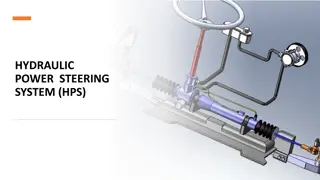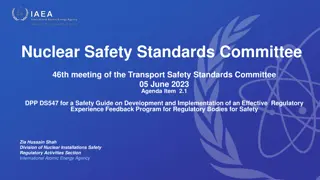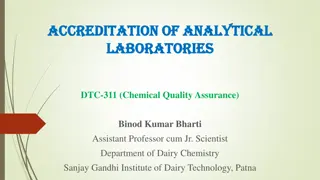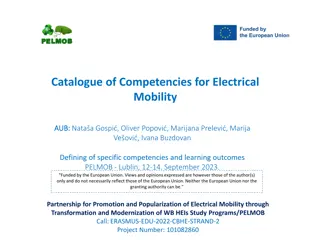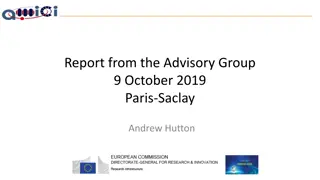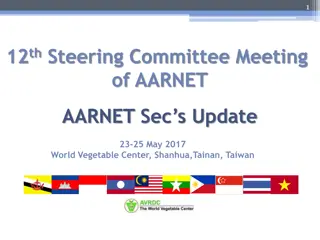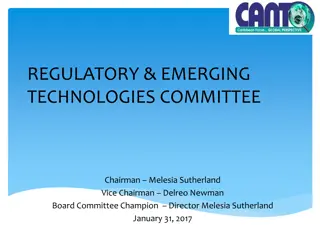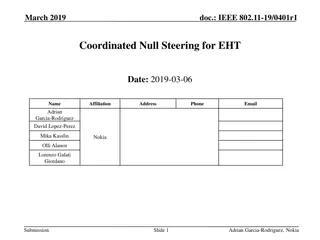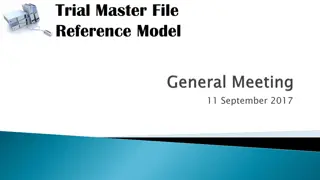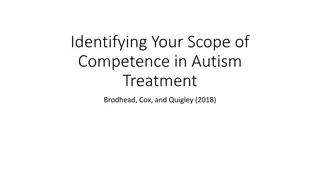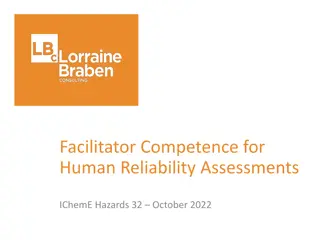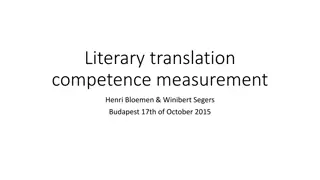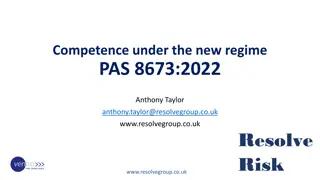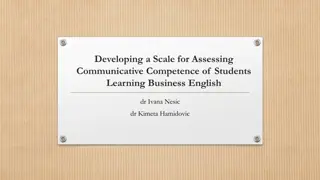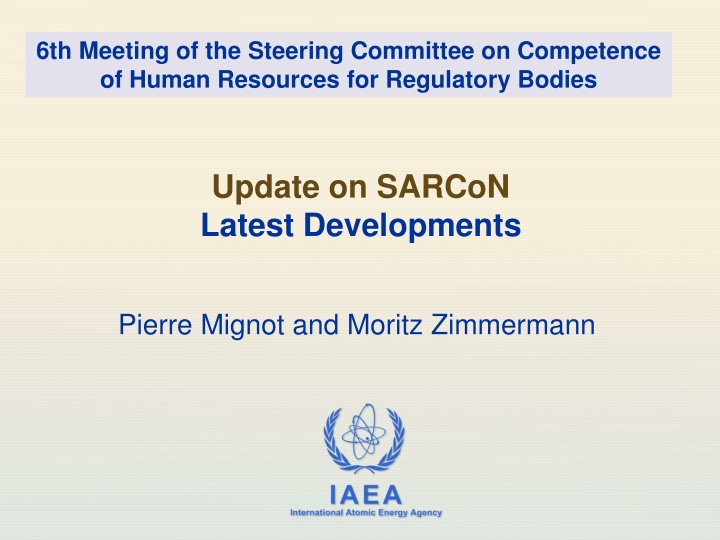
Steering Committee Update on Competence of Human Resources for Regulatory Bodies
Steering Committee meeting update on the Competence of Human Resources for Regulatory Bodies, including latest developments in SARCoN, IAEA publications and tools, missions since July 2012, and approaches to SARCoN. The content covers Competence Needs Assessment, SARCoN methodology, training program development, and recommendations for improvement.
Download Presentation

Please find below an Image/Link to download the presentation.
The content on the website is provided AS IS for your information and personal use only. It may not be sold, licensed, or shared on other websites without obtaining consent from the author. If you encounter any issues during the download, it is possible that the publisher has removed the file from their server.
You are allowed to download the files provided on this website for personal or commercial use, subject to the condition that they are used lawfully. All files are the property of their respective owners.
The content on the website is provided AS IS for your information and personal use only. It may not be sold, licensed, or shared on other websites without obtaining consent from the author.
E N D
Presentation Transcript
6th Meeting of the Steering Committee on Competence of Human Resources for Regulatory Bodies Update on SARCoN Latest Developments Pierre Mignot and Moritz Zimmermann IAEA International Atomic Energy Agency
CONTENT IAEA Publications and Tools Missions since July 2012 Competence Needs Assessment (CNA) Approaches to SARCoN SARCoN Methodology Typical Job Position Steps for developing a training programme Recommendations for improvement IAEA 2 6th SC Meeting - November 2014
IAEA Publications and Tools SRS N 79: Managing Regulatory Body Competence TECDOC TO BE PUBLISHED: Methodology for the Systematic Assessment of the Regulatory Competence Needs for Regulatory Bodies of nuclear installations SARCoN TOOL: SARCON_Tool_V1.409_RC_NI IAEA 3 6th SC Meeting - November 2014
Missions since July 2012 Expert missions or workshops related to SARCoN: Philippines (2 missions) Thailand (2 missions) Indonesia (2 missions, Regional), Poland Iran Jordan Egypt Turkey (2 missions) Vienna (IAEA) IAEA 4 6th SC Meeting - November 2014
Competence Needs Assessment (CNA) Competence management is an inherent part of the management system (SRS N 79) CNA process has to be integrated in the human resources management process Process 1: Development of competence profiles (required competences) as part of job descriptions Process 2: Competence gap analysis by comparison of existing competences with required ones (SARCoN tool) Training needs assessment (TNA) is the last phase of the competence management process IAEA 5 6th SC Meeting - November 2014
Approaches to SARCoN No. Level Basis 1 Organizational Quadrant areas (QAs) 2 Organizational KSAs 3 Individual Quadrant areas (QAs) 4 Individual KSAs IAEA 6 6th SC Meeting - November 2014
Initial step based approach Step 1 Regulatory functions Management Assessment Staff Step 2 Self-assessment Specific tasks Step 3 Step 4 Step 7 Required KSAs Existing personnel KSAs Periodic Review Step 5 Competence gap analysis Step 6 Training & Development, Reorganization, Recruitment or Outsourcing IAEA 7 6th SC Meeting - November 2014
New step based approach Process 1 Developing competence profiles Process 2 Competence gap analysis Process 3 Periodic review Existing competences Competence profiles Regulatory functions Step 1 Periodic Review Competence gap analysis Step 2 Specific tasks Training & development, reorganization, recruitment and outsourcing Competence profiles Step 3 IAEA 8 6th SC Meeting - November 2014
SARCoN Methodology |1 Process 1 Step 1: Determine the regulatory functions of each unit Step 2: Determine the specific tasks for each function Step 3: Developing competence profiles This step consists of 3 parts that can be conducted consecutively or separately: 1. Assessing the required level of competences per task on the basis of QAs or KSAs 2. Assigning tasks to positions and assessing competences to positions 3. Assigning positions to individuals or organizational units and assessing competences for individuals or organizational units IAEA 9 6th SC Meeting - November 2014
SARCoN Methodology |2 Process 2 Step 1: Determine the existing level of competence at the level of individuals (self-assessment) or organizational units Step 2: Perform Competence Gap Analysis with the SARCoN tool Step 3: Prioritization of the gaps and determining methods to fill them Available methods are: 1. Training & development, 2. Reorganization or reshuffling, 3. Recruitment, 4. Outsourcing. IAEA 10 6th SC Meeting - November 2014 .
SARCoN Methodology |3 Process 3 Periodic Review and Assessment Circumstances such as assignment of new regulatory functions and/or recruitment of new staff, may make it necessary to repeat the CNA process for the whole organization or the affected parts. Also strong emphasis on the periodic evaluation of the effectiveness of the training programme: Too much training? Not always adequate? Some areas of specialization are missing? Think about all modes of training? Foster continuous improvement IAEA 11 6th SC Meeting - November 2014
Legal Framework / organizational mandate IAEA Safety Standards Regulatory functions Management system Organizational structure Specific tasks Org. units / individuals Job positions Managers and supervisors Competence profiles Staff self- assessment Existing Competence Competence profiles Management system Managers and supervisors Competence gap analysis Education & training, reorganization, recruitment, outsourcing Periodic review and assessment of the analysis for continuous improvement IAEA 12
Typical job position |1 Safety Analysis Engineer (SAE) A. Name of the position and purpose The safety analyst engineer is in charge of carrying out the tasks that have been appointed to him, on the basis of his competence. These tasks may be permanent or time limited. He is responsible, within the scope of his work, for the production of services with adequate quality, in agreed time periods and agreed budgetary limits. B. Description of activities and tasks The main tasks of the Safety analysis engineer are: To perform safety analyses in the domain of his competence; To perform an independent review of safety analyses made by colleagues, when requested; To keep written records regarding the justifications of safety positions taken To contribute to the definition of safety positions To make himself acquainted with existing and new regulations and practices in his working area; To participate in updating the regulatory guides when requested, To participate in R&D activities when requested To represent the organization in international programmes or activities when requested C. Hierarchical and functional dependence Safety Analysis Engineer reports to a mid-manager. IAEA 13 6th SC Meeting - November 2014
Typical job position |2 D. Competence/Qualification requirements The qualifications required for this role are the following (non-exhaustive list): Education : Civil engineer, particularly with specializations in: Physics, Nuclear Science, Mechanical Engineering, Electrical Engineering, Chemical Engineering, Construction, IT, Geology Master in Physical Sciences, Chemical Sciences, ... Doctor in Applied Sciences Industrial engineer with specialization nuclear Practical knowledge, scientific or technical information: In-depth technical knowledge (which is kept up to date) of the material to be treated, however with a multidisciplinary view. Demonstrate sufficient open-mindedness and ability for (self) learning new materials, more or less depending on the targeted basic qualification area. If necessary, agree to be "coached" by more experienced staff. Can work both independent and in teams (perform actively and constructively in the technical reviews and methodologies for preparing the work). Demonstrate thoroughness, independence of judgment and a realistic view of the requirements of nuclear safety and radiation protection. Demonstrate strong analytical skills and excellent writing skills. Experience: This position can be occupied by newcomers who shall gradually be formed by training or experienced senior staff, which are more specialized in certain areas. IAEA 14 6th SC Meeting - November 2014
Typical job position |3 E. Knowledge, skills and attitudes The skills required for this position are defined by the supervisor on the basis of a list of knowledge, skills and attitudes based on the SARCoN questionnaire. These KSAs are associated with each of the four quadrants defined in the IAEA quadrant model of competences. The methodology is described in the SARCoN Guidelines. IAEA 15 6th SC Meeting - November 2014
Steps for developing a training programme 1) Choose the method for acquiring competence for each KSA; 2) Identify and assess the training needs (TNA) from the CNA results, if training is chosen to fill the gap; 3) List the training courses and materials available from different sources, such as the IAEA, regional networks and the own organization and map them to the KSAs of the quadrant model; IAEA 16 6th SC Meeting - November 2014
Steps for developing a training programme 4) Define the objectives of the training activity to be organized to satisfy the needs; 5) Identify the possible training modes for each KSA; 6) Prioritize the gaps taking into account the strategy of the regulatory body; 7) Select the appropriate training activities to fill the gaps as prioritized in step 6; 8) Establish the individual training programs which may consist of different training modes. IAEA 17 6th SC Meeting - November 2014
Recommendations for improvement More work needs to be done in the following areas: Further guidance for the integration of CNA processes into an existing management system Revision of the SARCoN tool to incorporate recent development in the methodology In the frame of implementation: Repeat the CNA every 3 to 4 years, especially if some changes occurred within the organization Review and assess the training programme periodically IAEA 18 6th SC Meeting - November 2014


